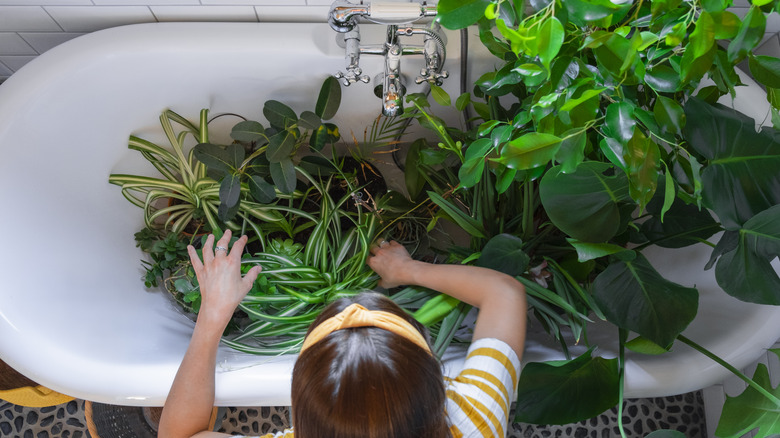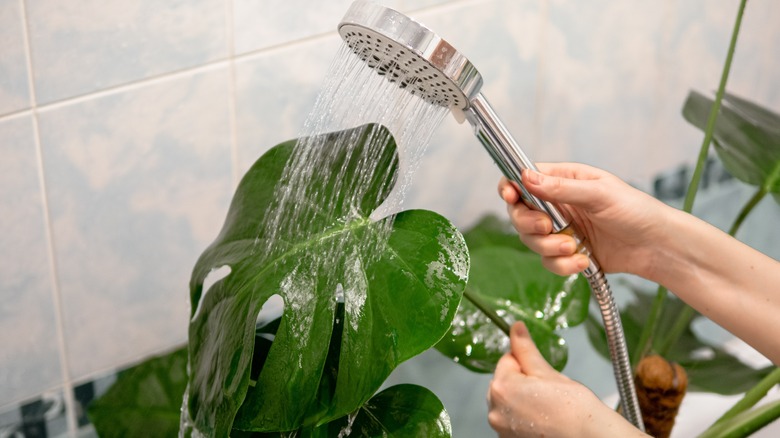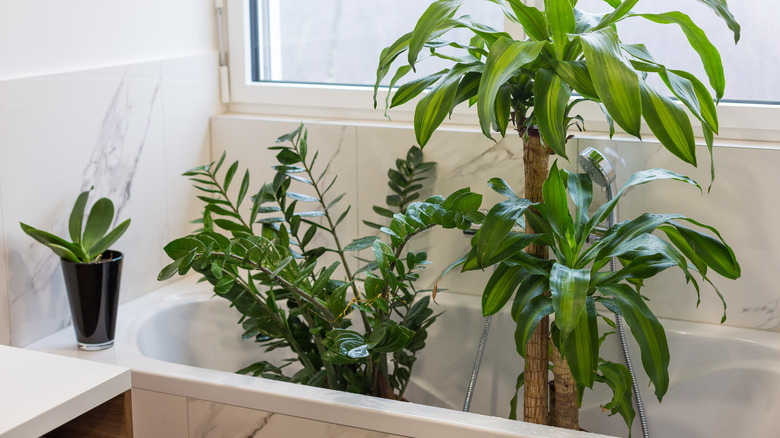Showering Your Indoor Houseplants: Good Practice Or Bad Idea?
According to Shakespeare's Globe, many people in Elizabethan England did not bathe very frequently — sometimes only a few times per year. The thought of adhering to that practice today would make most readers' skin crawl. It is widely accepted that showering regularly is good for one's health, so why should it be any different for your indoor plants? It's simple: Plants belong outside. What else is outside? Rain! Showering your plants from time to time mimics a natural occurrence from their native habitat, allowing them to thrive inside despite the lack of resources they'd receive outdoors.
Many tropical plants evolved in regions with periodic rain showers, and this watering method mimics that natural watering cycle. Simulating a rain environment maintains a more natural and healthy growth pattern for the plants. It can also contribute to a cleaner, pest-resistant environment, as pests are less likely to thrive on clean, well-hydrated plants.
One common myth suggests that showering indoor plants can lead to foliage diseases and fungal issues. The concern is that water on the leaves creates a humid environment, fostering the growth of pathogens that can harm the plant. While it's true that excessive moisture on foliage can contribute to fungal problems, occasional gentle showers with adequate time for drying actually mimic natural rain conditions. Proper ventilation and enough drying time between waterings can mitigate the risk of fungal issues, making periodic showers a safe and beneficial practice.
How to shower your indoor plants
If you'd like to give your plants a shower inside, there are a few tips to keep in mind to keep your plants happy and thriving and your shower clean and functioning. Choose a time of day to water your houseplants when they won't be in direct sunlight, preferably in the morning or late afternoon. This reduces the risk of any remaining water droplets on leaves magnifying sunlight and causing leaf burn. Furthermore, use lukewarm water to avoid shocking the plants with extreme temperatures. Adjust the showerhead to a gentle, rainfall-like spray to prevent soil compaction and potential damage to delicate foliage. A low to medium water pressure is ideal to simulate a natural rain shower.
Shower the plants about once a month, replacing a typical watering in their routine. A few minutes per plant should be sufficient depending on the size, shape, and type of plant. Pay attention to the water draining from the bottom of the pot to ensure even saturation. After active watering, allow the excess water to drain freely from the pots. Place the pots in an area where they can drain completely, ensuring there's no water accumulation in saucers. Proper drainage prevents waterlogged soil, which can lead to root rot.
To prevent drain clogs in the shower, consider using a mesh drain cover or placing a layer of small stones or pebbles over the drain. This helps catch any soil particles or debris that might contribute to clogging.
Benefits of showering your plants
Showering your indoor houseplants from time to time offers several benefits that contribute to the well-being of the plants, helping them thrive. First, it allows for a more even and thorough distribution of water. The gentle rainfall effect ensures that water reaches all parts of the plant, including the leaves, stems, and soil surface. This promotes uniform hydration and helps prevent waterlogged or dry spots in the soil. Additionally, wetting the foliage can improve humidity levels, benefiting plants that thrive in more humid environments.
Since houseplants typically do not experience wind, they often accumulate dust on their leaves, which can hinder their ability to photosynthesize effectively. Showering the plants helps to remove dust and dirt, allowing the leaves to breathe and absorb light more efficiently. Clean, dust-free leaves enable optimal photosynthesis, as they can capture sunlight more effectively. This, in turn, enhances the plant's overall growth, vitality, and ability to produce energy through the conversion of sunlight into nutrients.
Regularly showering indoor plants acts as a preventive measure against pests, including spider mites. These pests thrive in dry conditions and can be deterred by maintaining a higher humidity level around the plants. The showering process not only cleans the plant but also enhances the ambient humidity, creating an environment less favorable for pests while also physically removing them from the plant's leaves. By reducing the risk of infestations, showering contributes to the plant's well-being and longevity.


